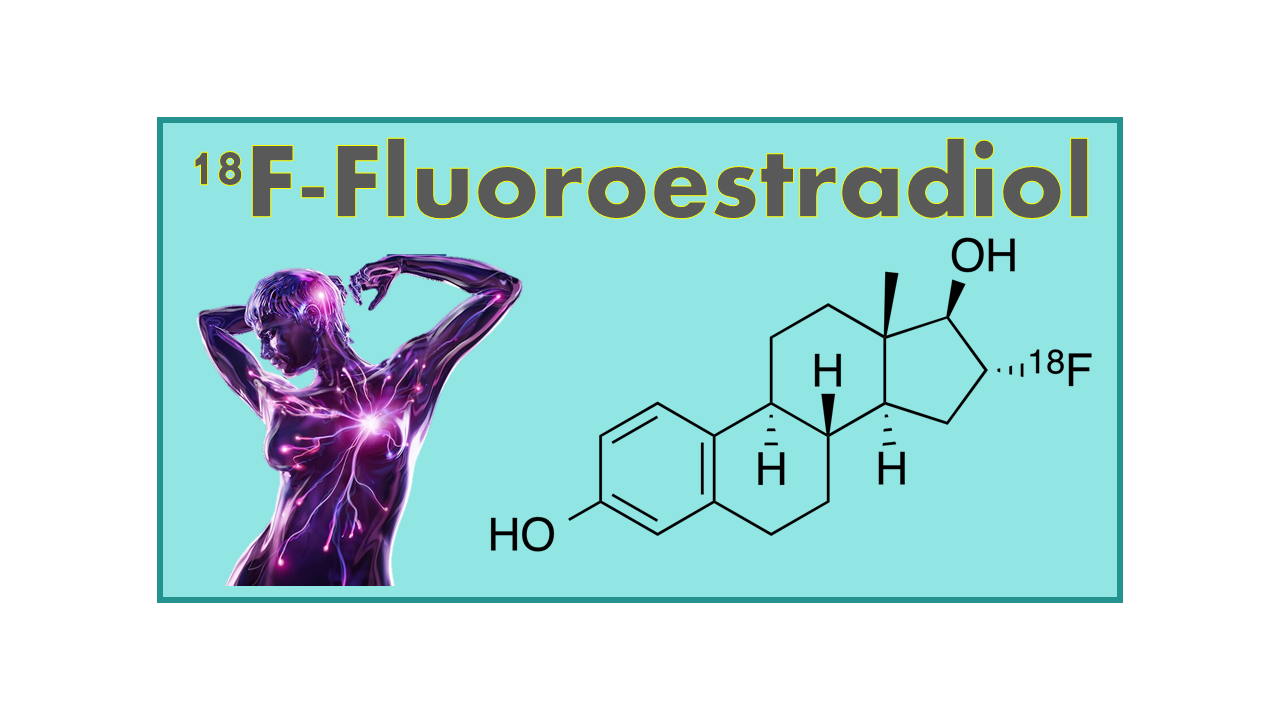
18F-Fluoroestradiol (FES)
February 24, 2024
18F-Fluoroestradiol (FES) is a radiopharmaceutical used in positron emission tomography (PET) imaging for the detection of estrogen receptor-positive (ER+) breast cancer. It is a synthetic estrogen analog labeled with the radioactive isotope fluorine-18, which allows it to be detected and visualized in the body using PET scanning technology.
Estrogen receptor-positive breast cancer is a common subtype of breast cancer that is characterized by the presence of estrogen receptors on the surface of cancer cells. These receptors play a key role in the growth and proliferation of ER+ breast cancer cells. FES PET imaging works by binding to estrogen receptors on cancer cells, allowing for the visualization and quantification of estrogen receptor expression in the tumor.
FES PET imaging is used to assess the status of estrogen receptors in breast cancer patients, providing valuable information for treatment planning and monitoring. It can help determine the presence and extent of ER+ breast cancer lesions, as well as predict response to hormone therapy and monitor treatment efficacy over time.
Overall, FES PET imaging has shown promise as a non-invasive and sensitive imaging tool for the evaluation of ER+ breast cancer, offering important insights into tumor biology and guiding personalized treatment strategies for patients with this subtype of breast cancer. It is considered safe and well-tolerated, with minimal side effects reported in patients undergoing FES PET scans.
Description
18F-Fluoroestradiol (18F-FES, 18F-16α-fluoro-17β-estradiol) is an analogue of estradiol which binds with high affinity to the antigen receptor in breast cancer. 18F-FES can be considered as a generic product even if a few patents claiming the coverage of some fluorination processes could infringe the IP of 18F-FES. Despite this generic character, 18F-FES became the most recent PET agent on the US and/or EU markets with an official marketing authorization supported by local manufacturers.
18F-Fluoroestradiol obtained its MA in France in July 2016 and the product was launched by Cyclopharma in October 2016 under the brand name EstroTep®. However, in July 2017, the French High Health Authority (HAS: Haute Autorité de la Santé) released a document in which it was stated that “the clinical service rendered by EstroTep is insufficient in the “characterization of known or suspected metastatic lesions as expressing estrogen receptors in adult breast cancer, initially expressing the estrogen receptor”. In other word this means that this tracer will not be reimbursed as long as a better clinical proof is available.
Following the sales of Cyclopharma’s PET assets to Curium, the company Zionexa was created to continue the development of former’s Cyclopharma’s R&D program including 18F-FES. In the meantime, Zionexa signed an exclusive agreement with PETNET for the production of 18F-FES in the USA. In May 2020, 18F-Fluoroestradiol obtained a MA from the FDA for sale in the USA and the tracer became available by end of 2020 under the brand name Cerianna.
In April 2021, GEH took over the company Zionexa.
Clinical applications
18F-Fluoroestradiol is an agent for the imaging of metastases of tumors (mainly breast cancer) that have been shown to be hormone positive. Patient tumors showing this relation are good candidates for hormonal treatment. 18F-FES is a selection tool for potential positive responders to hormonotherapy. Average patient dose is comprised between 4 and 8 mCi.
By end of 2020, Japanese researchers not only found that standardized uptake values (SUV) from FES-PET scans of the primary tumor were independent prognostic factors for progression-free survival but also were “significantly associated” with chances for overall survival. Use of 18F-FES could be useful in determining therapeutic strategies and could improve the prognosis for patients with endometrial cancer.
Stage of development
18F-FES was involved in several Phase II clinical trials for predicting responses to hormone therapy in breast cancer and a few in ovarian cancers. All these trials have been performed with governmental institutions only, without the involvement of industrial partners.
The American College of Radiology Imaging Network (USA) coordinated a multicenter clinical trial with 18F-FES started in 2014. A phase III trial to assess the estrogen receptor expression status of recurrent or metastatic breast cancer1 was completed by end of 2015. Several new studies have been launched in 2015, showing the high interest for this tracer.2 Additional studies have been started in 2016 and 2017.3 Zionexa made the tracer available on the US market by end of 2020 through the PETNET radiopharmacies network.
GMP grade 18F-FES is available from Map Medical / Curium (Finland).
Comments
Although this tracer shows important advantages in the cancer therapy process and selection of patients, the routine use of this tracer is presently limited to a very small number of centers and its extension will now highly depend upon the collaboration contracts and investments made by Zionexa in different countries on the basis of the approved market authorization.
- https://www.clinicaltrials.gov/ct2/show/NCT01986569 :Diagnostic Accuracy and Safety Study of FES PET/CT in Assessment of ER Status of Recurrent or Metastatic Breast Cancer ↩︎
- https://www.clinicaltrials.gov/ct2/show/NCT02374931 : 18F-FES PET/CT in Imaging Patients With Desmoid Tumors
https://www.clinicaltrials.gov/ct2/show/NCT02398773 : FES PET/CT in Predicting Response in Patients With Newly Diagnosed Metastatic Breast Cancer Receiving Endocrine Therapy
https://www.clinicaltrials.gov/ct2/show/NCT01988324 : AR and ER Imaging in Metastatic Breast Cancer (study involving the use of 18F-FES but also 18F-FDHT (18F-Fluorohydrotestosterone)) ↩︎ - https://www.clinicaltrials.gov/ct2/show/NCT02398773 : FES PET/CT in Predicting Response in Patients With Newly Diagnosed Metastatic Breast Cancer Receiving Endocrine Therapy
https://www.clinicaltrials.gov/ct2/show/NCT02899533 : 18F-FES PET/CT in PAH
https://www.clinicaltrials.gov/ct2/show/NCT03065712 : Test – Retest Reproducibility of 18F Fluoroestradiol (FES) PET ↩︎